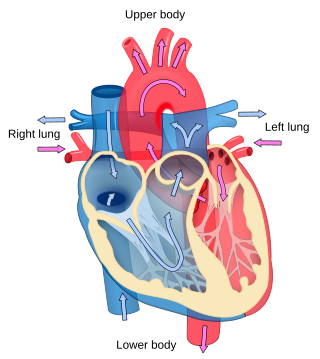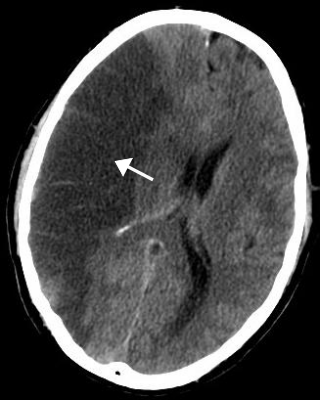Related Research Articles

Aspirin, also known as acetylsalicylic acid (ASA), is a nonsteroidal anti-inflammatory drug (NSAID) used to reduce pain, fever, and/or inflammation, and as an antithrombotic. Specific inflammatory conditions which aspirin is used to treat include Kawasaki disease, pericarditis, and rheumatic fever.

Cardiology is the study of the heart. Cardiology is a branch of medicine that deals with disorders of the heart and the cardiovascular system. The field includes medical diagnosis and treatment of congenital heart defects, coronary artery disease, heart failure, valvular heart disease and electrophysiology. Physicians who specialize in this field of medicine are called cardiologists, a speciality of internal medicine. Pediatric cardiologists are pediatricians who specialize in cardiology. Physicians who specialize in cardiac surgery are called cardiothoracic surgeons or cardiac surgeons, a speciality of general surgery.

Coronary artery disease (CAD), also called coronary heart disease (CHD), ischemic heart disease (IHD), myocardial ischemia, or simply heart disease, involves the reduction of blood flow to the heart muscle due to build-up of atherosclerotic plaque in the arteries of the heart. It is the most common of the cardiovascular diseases. Types include stable angina, unstable angina, myocardial infarction, and sudden cardiac death. A common symptom is chest pain or discomfort which may travel into the shoulder, arm, back, neck, or jaw. Occasionally it may feel like heartburn. Usually symptoms occur with exercise or emotional stress, last less than a few minutes, and improve with rest. Shortness of breath may also occur and sometimes no symptoms are present. In many cases, the first sign is a heart attack. Other complications include heart failure or an abnormal heartbeat.
A transient ischemic attack (TIA), commonly known as a mini-stroke, is a minor stroke whose noticeable symptoms usually end in less than an hour. TIA causes the same symptoms associated with strokes, such as weakness or numbness on one side of the body, sudden dimming or loss of vision, difficulty speaking or understanding language, slurred speech, or confusion.

Angina, also known as angina pectoris, is chest pain or pressure, usually caused by insufficient blood flow to the heart muscle (myocardium). It is most commonly a symptom of coronary artery disease.

Statins, also known as HMG-CoA reductase inhibitors, are a class of lipid-lowering medications that reduce illness and mortality in those who are at high risk of cardiovascular disease. They are the most common cholesterol-lowering drugs.

Aortic stenosis is the narrowing of the exit of the left ventricle of the heart, such that problems result. It may occur at the aortic valve as well as above and below this level. It typically gets worse over time. Symptoms often come on gradually with a decreased ability to exercise often occurring first. If heart failure, loss of consciousness, or heart related chest pain occur due to AS the outcomes are worse. Loss of consciousness typically occurs with standing or exercising. Signs of heart failure include shortness of breath especially when lying down, at night, or with exercise, and swelling of the legs. Thickening of the valve without narrowing is known as aortic sclerosis.

Cardiovascular disease (CVD) is any disease involving the heart or blood vessels. CVDs constitute a class of diseases that includes: coronary artery diseases, stroke, heart failure, hypertensive heart disease, rheumatic heart disease, cardiomyopathy, abnormal heart rhythms, congenital heart disease, valvular heart disease, carditis, aortic aneurysms, peripheral artery disease, thromboembolic disease, and venous thrombosis.

A stroke is a medical condition in which poor blood flow to the brain causes cell death. There are two main types of stroke: ischemic, due to lack of blood flow, and hemorrhagic, due to bleeding. Both cause parts of the brain to stop functioning properly.

Acute coronary syndrome (ACS) is a syndrome due to decreased blood flow in the coronary arteries such that part of the heart muscle is unable to function properly or dies. The most common symptom is centrally located pressure-like chest pain, often radiating to the left shoulder or angle of the jaw, and associated with nausea and sweating. Many people with acute coronary syndromes present with symptoms other than chest pain, particularly women, older people, and people with diabetes mellitus.

P2Y12 is a chemoreceptor for adenosine diphosphate (ADP) that belongs to the Gi class of a group of G protein-coupled (GPCR) purinergic receptors. This P2Y receptor family has several receptor subtypes with different pharmacological selectivity, which overlaps in some cases, for various adenosine and uridine nucleotides. The P2Y12 receptor is involved in platelet aggregation and is thus a biological target for the treatment of thromboembolisms and other clotting disorders. Two transcript variants encoding the same isoform have been identified for this gene.
Acronyms are very commonly used in healthcare settings. They are formed from the lead letters of words relating to medications, organisations, procedures and diagnoses. They come from both English and Latin roots. Acronyms have been described as jargon. and their use has been shown to impact the safety of patients in hospitals, owing to ambiguity and legibility.

A myocardial infarction (MI), commonly known as a heart attack, occurs when blood flow decreases or stops in the coronary artery of the heart, causing damage to the heart muscle. The most common symptom is chest pain or discomfort which may travel into the shoulder, arm, back, neck or jaw. Often it occurs in the center or left side of the chest and lasts for more than a few minutes. The discomfort may occasionally feel like heartburn. Other symptoms may include shortness of breath, nausea, feeling faint, a cold sweat or feeling tired. About 30% of people have atypical symptoms. Women more often present without chest pain and instead have neck pain, arm pain or feel tired. Among those over 75 years old, about 5% have had an MI with little or no history of symptoms. An MI may cause heart failure, an irregular heartbeat, cardiogenic shock or cardiac arrest.
Jonathan L. Halperin is an American cardiologist and the author of Bypass (ISBN 0-89586-509-2), among the most comprehensive works on the subject of coronary artery bypass surgery. In addition, he is the Robert and Harriet Heilbrunn Professor of Medicine at The Mount Sinai School of Medicine as well as Director of Clinical Cardiology in the Zena and Michael A. Wierner Cardiovascular Institute at The Mount Sinai Medical Center, both in New York City. Halperin was the principal cardiologist responsible for both the design and execution of the multi-center Stroke Prevention in Atrial Fibrillation (SPAF) clinical trials, funded by the National Institutes of Health, which helped develop antithrombotic strategies to prevent stroke, and he subsequently directed the SPORTIF clinical trials, which evaluated the first oral direct thrombin inhibitor for prevention of stroke in patients with atrial fibrillation.

Philip Alexander Poole-Wilson FRCP, FESC, FACC, FMedSci was a British academic cardiologist of international reputation who had particular interest in the management of heart failure. His research helped to identify the cellular mechanisms behind heart failure and was also important in improving treatment for patients. He was instrumental in raising the profile of heart failure as a major public health problem.

The Caerphilly Heart Disease Study, also known as the Caerphilly Prospective Study (CaPS), is an epidemiological prospective cohort, set up in 1979 in a representative population sample drawn from Caerphilly, a typical small town in South Wales, UK.
Professor Peter Sleight M.D.(Cantab.), D.M. (Oxon.) FRCP FACC was a distinguished and internationally renowned research cardiologist and an Honorary Consultant Physician at the John Radcliffe Hospital in Oxford and the Oxford University Hospitals NHS Foundation Trust. Sleight was Emeritus Field Marshal Alexander Professor of Cardiovascular Medicine at the University of Oxford and an Emeritus Fellow of Exeter College, Oxford.
Remote ischemic conditioning (RIC) is an experimental medical procedure that aims to reduce the severity of ischaemic injury to an organ such as the heart or the brain, most commonly in the situation of a heart attack or a stroke, or during procedures such as heart surgery when the heart may temporary suffer ischaemia during the operation, by triggering the body's natural protection against tissue injury. Although noted to have some benefits in experimental models in animals, this is still an experimental procedure in humans and initial evidence from small studies have not been replicated in larger clinical trials. Successive clinical trials have failed to identify evidence supporting a protective role in humans.
Major adverse cardiovascular events is a composite endpoint frequently used in cardiovascular research. Despite widespread use of the term in clinical trials, the definitions of MACE can differ, which makes comparison of similar studies difficult.
References
- ↑ Lowe, Derek (18 July 2019). "Acronym Fever. We Need an Acronym For That". In the Pipeline. Retrieved 1 May 2020.
- ↑ Stanbrook, Matthew B.; Austin, Peter C.; Redelmeier, Donald A. (6 July 2006). "Acronym-Named Randomized Trials in Medicine — The ART in Medicine Study". New England Journal of Medicine. 355 (1): 101–102. doi:10.1056/NEJMc053420. PMID 16823008.
- 1 2 Fred, Herbert L.; Cheng, Tsung O. (2003). "Acronymesis". Texas Heart Institute Journal. 30 (4): 255–257. ISSN 0730-2347. PMC 307708 . PMID 14677733.
- 1 2 Pottegård, Anton; Haastrup, Maija Bruun; Stage, Tore Bjerregaard; Hansen, Morten Rix; Larsen, Kasper Søltoft; Meegaard, Peter Martin; Meegaard, Line Haugaard Vrdlovec; Horneberg, Henrik; Gils, Charlotte; Dideriksen, Dorthe; Aagaard, Lise; Almarsdottir, Anna Birna; Hallas, Jesper; Damkier, Per (16 December 2014). "SearCh for humourIstic and Extravagant acroNyms and Thoroughly Inappropriate names For Important Clinical trials (SCIENTIFIC): qualitative and quantitative systematic study". BMJ. 349: g7092. doi:10.1136/bmj.g7092. ISSN 1756-1833. PMC 4267482 . PMID 25516539.
- 1 2 3 Berkwits, Michael (7 November 2000). "CAPTURE! SHOCK! EXCITE! Clinical Trial Acronyms and the "Branding" of Clinical Research". Annals of Internal Medicine. 133 (9): 755–62. doi:10.7326/0003-4819-133-9-200011070-00039. PMID 11074930. S2CID 31188922.
- ↑ Isaacs, D.; Fitzgerald, D. (December 2000). "Acronymophilia: an update". Archives of Disease in Childhood. 83 (6): 517–518. doi:10.1136/adc.83.6.517. ISSN 0003-9888. PMC 1718581 . PMID 11087292.
- ↑ Cheng, Tsung O. (1 November 2009). "What is the ZAHARA study? Acronymania is an incurable Disease Afflicting MAiNly the cardiologisTs (ADAMANT)". International Journal of Cardiology. 137 (3): 289. doi:10.1016/j.ijcard.2008.05.056. PMID 18692260 . Retrieved 1 May 2020.
- ↑ Cheng, Tsung O. (5 April 2000). "PASTA is good, but SUSHI is better". Catheterization and Cardiovascular Interventions. 49 (4): 478–479a. doi:10.1002/(SICI)1522-726X(200004)49:4<478::AID-CCD29>3.0.CO;2-P. PMID 10751783.
- 1 2 "Clinical trial names can be quite AMUSING, but they don't include unicorns : Spoonful of Medicine". blogs.nature.com. Retrieved 1 May 2020.